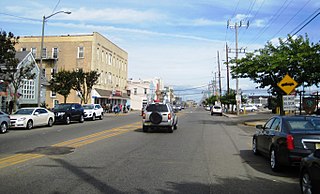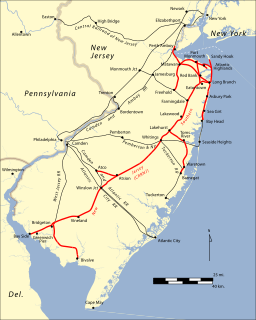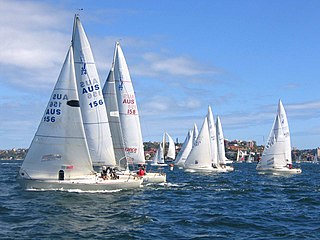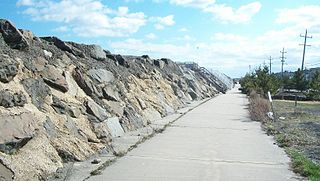
Yachting is the use of recreational boats and ships called yachts for racing or cruising. Yachts are distinguished from working ships mainly by their leisure purpose. "Yacht" derives from the Dutch word jacht ("hunt"). With sailboats, it is the activity is called sailing, and with motorboats, it is called powerboating.

Yacht racing is a sailing sport involving sailing yachts and larger sailboats, as distinguished from dinghy racing, which involves open boats. It is composed of multiple yachts, in direct competition, racing around a course marked by buoys or other fixed navigational devices or racing longer distances across open water from point-to-point. It can involve a series of races when buoy racing or multiple legs when point-to-point racing.
Route 36 is a state highway in Monmouth County, New Jersey, United States. The 24.40-mile (39.27 km) long route, shaped as a backwards C, begins at an intersection with Garden State Parkway and County Route 51 in Eatontown and runs east to Long Branch. From Long Branch, the route follows the Atlantic Ocean north to Sea Bright and turns west, running to the south of the Raritan Bay. Route 36 ends in Keyport at an interchange with the Garden State Parkway and Route 35. It varies in width from a six-lane divided highway to a two-lane undivided road. The route is signed east–west between Eatontown and Long Branch and north–south between Long Branch and Keyport.

Sea Bright is a borough in Monmouth County, New Jersey, United States. As of the 2010 United States Census, the borough's population was 1,412, reflecting a decline of 406 (-22.3%) from the 1,818 counted in the 2000 Census, which had in turn increased by 125 (+7.4%) from the 1,693 counted in the 1990 Census.

Dinghy sailing is the activity of sailing small boats by using five essential controls:
Bruce Kenneth Farr is a New Zealand designer of racing and cruising yachts. Farr‑designed boats have won, challenged for, or placed highly in the Whitbread Round the World Race, America's Cup, and Sydney to Hobart Yacht Race, among others.

The Jersey Shore is the coastal region of the U.S. state of New Jersey. Geographically, the term encompasses about 141 miles (227 km) of oceanfront bordering the Atlantic Ocean, from Perth Amboy in the north to Cape May Point in the south. The region includes Middlesex, Monmouth, Ocean, Atlantic, and Cape May counties. Many New Jersey residents refer to it simply as The Shore. Most of the shore region is located in Central and South New Jersey.
The Shrewsbury River is a short stream and navigable estuary, approximately 8 mi (13 km) long, in central New Jersey in the United States.
The Jersey Skiff is a beach launched boat first appearing around the end of the 19th century. They were first used as fishing boats, to be launched through the surf, sailed to the fishing grounds and then retrieved through the surf.
The Sea Bright Skiff is a box-skegged skiff developed on the northern shore of New Jersey. It was used for fishing, by being launched through the surf, sailed to the fishing grounds, and returned through the surf.

Frank Samuelsen and George Harbo were Norwegian-born Americans who in 1896 became the first people ever to row across an ocean. Their time record for rowing the North Atlantic Ocean was not broken for 114 years, and then by four rowers instead of two.

Coastal and offshore rowing is a type of rowing performed at sea. Due to the harsher conditions encountered, the boats are wider and more robust than those used on rivers and lakes. In North America, this sport is often called open water rowing.

A sneakbox is a small boat that can be sailed, rowed, poled or sculled. It is predominantly associated with the Barnegat Bay in New Jersey, just as the canoe-like Delaware Ducker is associated with the New Jersey marshes along the Delaware River near Philadelphia.

The New Jersey Southern Railroad was a railroad that started in 1854. It would continue under this name until the 1870s as a separate company and the lines that it had constructed or run continued to be run in the New Jersey Southern name until the early 2000s.

Alexander Robertson & Sons was a boatyard in Sandbank, Argyll and Bute, Scotland, from 1876 to 1980. The yard was located on the shore of the Holy Loch, near the world famous Royal Clyde Yacht Club (RCYC) at Hunter's Quay, which was the epicentre of early Clyde yachting. Alexander Robertson started repairing boats in a small workshop at Sandbank, Argyll in 1876, and went on to become one of the foremost wooden boat-builders on Scotland's River Clyde. The 'golden years' of Robertson's yard were in the early 1900s when they started building some of the first IYRU 12mR & 15mR racing yachts. Robertson's was well known for the quality of its workmanship and was chosen to build the first 15-metre yacht designed by William Fife III. More than 55 boats were built by Robertson's in preparation for the First World War and the yard remained busy even during the Great Depression in the 1930s, as many wealthy businessmen developed a passion for yacht racing on the Clyde. During World War II the yard was devoted to Admiralty work, producing a wide range of large high speed Fairmile Marine Motor Boats. After the war the yard built the successful one-class Loch Longs and two 12-metre challengers for the America's Cup: Sceptre (1958) and Sovereign (1964). Due to difficult business conditions the Robertson family sold the yard in 1965, and it was turned over to GRP production work until it closed in 1980. During its 104-year history, Robertson's Yard built 482 numbered boats, many of which are still sailing today.

William Reid Stowe is an American artist and mariner. Stowe grew up around sailboats on the East Coast, sailing on the Pacific and Atlantic Oceans in his late teens and early twenties. By age 26, he had built two of his own sailboats with the help of his family and friends. Stowe subsequently sailed to the Antarctic with his schooner Anne in 1986 and completed a 194-day journey without touching land in 1999.

In sailing and boating, a vessel's freeboard is the distance from the waterline to the upper deck level, measured at the lowest point of sheer where water can enter the boat or ship. In commercial vessels, the latter criterion measured relative to the ship's load line, regardless of deck arrangements, is the mandated and regulated meaning.

The sport of sailing involves a variety of competitive sailing formats that are sanctioned through various sailing federations and yacht clubs. Racing disciplines include matches within a fleet of sailing craft, between a pair thereof or among teams. Additionally, there are specialized competitions that include setting speed records. Racing formats include both closed courses and point-to-point contests; they may be in sheltered waters, coast-wise or on the open ocean. Most competitions are held within defined classes or ratings that either entail one type of sailing craft to ensure a contest primarily of skill or rating the sailing craft to create classifications or handicaps.

A Bristol Channel pilot cutter is a specialised sailing boat the style and design of which is derived from the single-masted cutter. Based upon bulkier, less nimble fishing boats but modified for use in the strong tides, winds, currents and coastline of the Bristol Channel its purpose was to quickly ferry local maritime pilots to and from large ships to assist in safe navigation into or out of port cities in the Channel. The speed and manoeuvrability of the cutters allowed a minimal crew in almost any weather. They could quickly arrive at and easily lie alongside larger ships for safe transfer of pilots. The craft was equipped to remain on station for days or even weeks, awaiting arrivals outside the channel.

The Sea Bright–Monmouth Beach Seawall is a seawall located along the Jersey Shore in the Monmouth County, New Jersey towns of Sea Bright and Monmouth Beach. It roughly runs north-south direction along 4.7 miles (7.6 km) of the barrier spit of land along the lower Sandy Hook peninsula between the Atlantic Ocean and the Shrewsbury River estuary. The use of seawalls, groins, jetties, bulkheads, revetment, and beach nourishment since the late 1800s has made the stretch of coast one of the most heavily engineered sections of ocean shorefront in the world.















